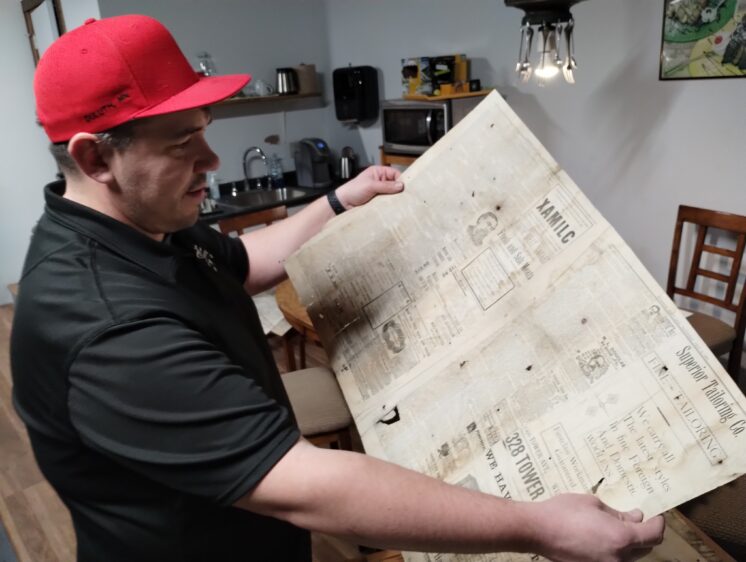Advertisements from the Duluth Public Library Nostalgic Newsstand Sale: Pierce-Arrow
The Duluth Public Library’s Nostalgic Newsstand Sale was clever and pleasurable for a number of reasons.
The Duluth Public Library’s Nostalgic Newsstand Sale was clever and pleasurable for a number of reasons.

Duluth Grill Family of Restaurants co-owner Louis Hanson looks over a newspaper from 1893. The business is renovating the former Duluth Press building and discovered dozens of newspapers in the floorboards. (Photos by Mark Nicklawske)
Buffalo Bill Cody has been buried under the floorboards of a historic Duluth building for 130 years.
Owners of a Lincoln Park business recently discovered a variety of 19th century newspapers inside a building financed by the legendary wild west star and used by his sister to operate a weekly news publication. The treasure trove turned up during major building renovations this winter.
The Duluth News Tribune reports the sidewalk and stairway that marks the location of the former Incline Railway at Seventh Avenue West, designated as a recreational hiking trail, will soon have interpretive signage.
Travelers in Minnesota who want to experience the golden age of the tourist trap are a few decades late, but a handful of the kitschy roadside attractions still remain. This short documentary takes viewers on the open road in search of adventure, cheap souvenirs and a room full of chainsaws.
Minnesota Historia is a PBS North web series dedicated to Minnesota’s quirky past. It is hosted by Hailey Eidenschink and produced/edited/written by Mike Scholtz.
Git yer flannel on. This undated postcard from Isle Royale was published by the National Park Commissions and is at least 20 years old.
One of the fastest, coolest, most beloved mail carriers who ever lived was Minnesota’s own John Beargrease. Hear the story of how he delivered mail in northeastern Minnesota before there were roads, and learn why there’s a sled dog marathon named after him.
Minnesota Historia is a PBS North web series dedicated to Minnesota’s quirky past. It is hosted by Hailey Eidenschink and produced/edited/written by Mike Scholtz.
This photo by Lyman E. Nylander is dated April 28, 1963 — 60 years ago today. It shows several Canal Park icons — the Aerial Lift Bridge, Duluth Harbor North Breakwater Lighthouse, Uncle Harvey’s Mausoleum — but the Duluth Lakewalk is still decades away from being built.
Because of the I-35 tunnel, with Gichi-ode’ Akiing / Lake Place Park built on top of it, shooting a modern photo from this perspective would be either challenging or impossible.
This image is from a postcard mailed 115 years ago today — April 26, 1908. The writing on the front of the card appears to refer to it as a “new style winding on the hoist motor” in use in Duluth. Perhaps engine experts and handwriting analysts can help correct or affirm this phrase and provide some description of what it means.
Part 1: Background
About five years ago I came across the article Du Luth’s Birthplace: A Footnote to History. In 1966, the author visited the French village where Duluth’s namesake was born and documented the few traces of him that remained. The article is well researched (all the quotes from Sieur du Lhut used here are taken from it) but the images are low resolution scans of black and white photos taken more than 50 years ago. I wanted to see more of what the place actually looks like.
This mystery photo is another from the studio of the fiery ol’ Swede Lars Liden. Penned on the photo is something along the lines of “f. d. Capt. Axel Strom.”
It seems somewhat clear that the photo is of the captain of some fire department, and since the photo was shot in Duluth it is likely this captain represents Duluth or some municipality near Duluth. So, Axel Strom? Is that the name?
Take a peek at April Fools’ Days of yesteryear with this week’s quiz!
The next PDD quiz will review April 2023 headlines; it will come your way on April 30. Please submit question suggestions to Alison Moffat at [email protected] by April 26.
The 2023 Homegrown Music Festival runs April 30 to May 7, and the annual Field Guide for the event was trucked into Duluth this morning. Piles of them will be available at local music venues within the coming days.
This year’s festival features 171 acts at 36 venues over the course of eight days.
This undated postcard shows the Riverview Motel in West Duluth, which operated during the latter half of the 1900s and was replaced in the early 2000s by Westgate Townhomes.
Duluth & Iron Range Railroad locomotive No. 3, known as “Three Spot,” was built 140 years ago, in 1883, by Philadelphia-based Baldwin Locomotive Works. It has been on display at the D&IR Depot in Two Harbors since 1923 — a solid century. This photo is estimated to be from the 1940s.